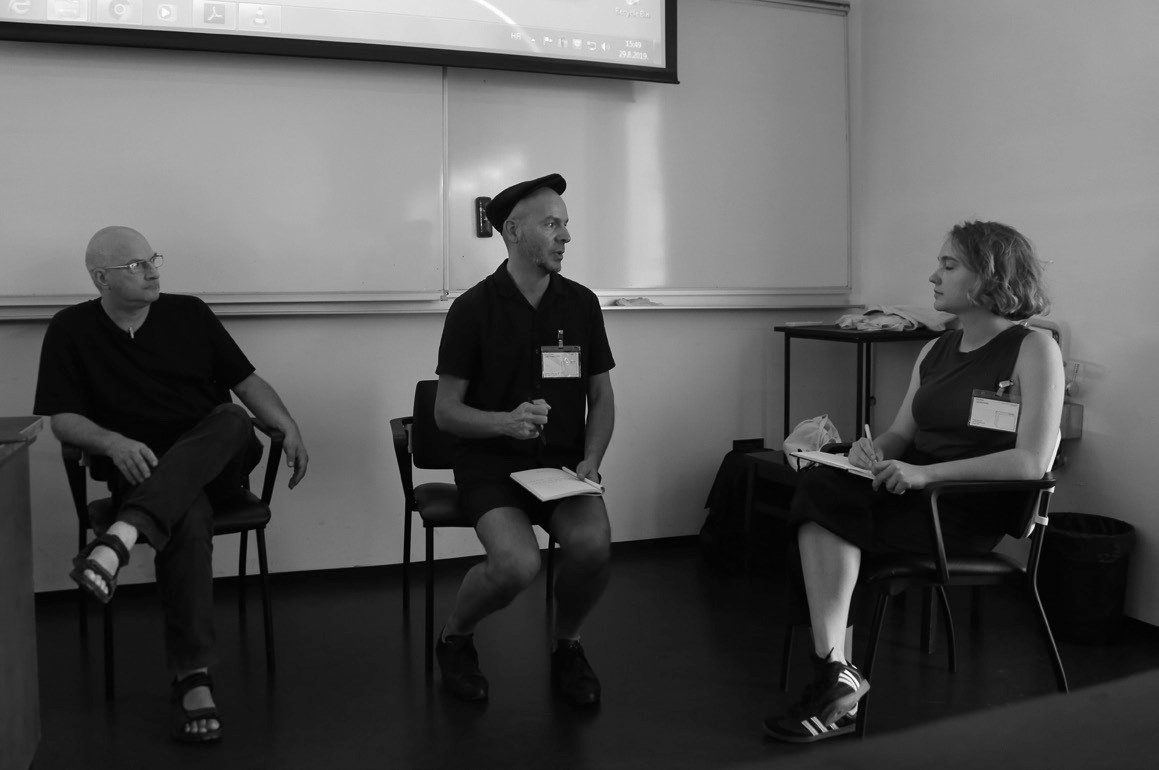A Hidden Perspective in First Year Design Studio
Downloads
DOI:
https://doi.org/10.51588/eaaeacp.70Keywords:
student’s experience, first-year experience, independent learning, engagement, design studioAbstract
The purpose of the design studio, which is the core of architectural education, is to educate the students to understand the nature of design, to think independently, to act in “designerly ways”, and to become “reflective practitioners”. The student must take on a new mode of learning, in which the main way to learn is by doing, and in which there is no one correct way to approach the design problem. The previous aspects associated with the studio — together with the open-ended, exploratory, and iterative nature of the design process — place the student at the center of the learning experience. Tutors in this context are facilitators of learning, rather than knowledge experts, and are expected to pay attention to the challenges that face students in adapting to this new learning environment and in assuming a new learner identity. Hence, this study employs longitudinal mixed approaches to uncover an emic perspective of the ways architecture students conceptualize learning in their first year and what distinguishes them from students in other disciplines.
How to Cite
Published
Issue
Section
License
Copyright (c) 2020 Dua Al Maani

This work is licensed under a Creative Commons Attribution 4.0 International License.
References
Argyris, C. (1981). Teaching and learning in design settings. Architecture education study, 1, 551–660.
Blythman, M., Orr, S., & Blair, B. (2007). Critiquing the crit. Brighton: Art, Design and Media Subject.
Brooman, S., & Darwent, S. (2012). A positive view of first-year undergraduate reflective diaries: Focusing on what students can do. Reflective Practice, 13(4), 517–531.
Brooman, S., & Darwent, S. (2014). Measuring the beginning: a quantitative study of the transition to higher education. Studies in Higher Education, 39(9), 1523–1541.
Chickering, A. W., & Gamson, Z. F. (1987). Seven principles for good practice in undergraduate education. AAHE bulletin, 3, 7.
Craig, D. L., &Zimring, C. (2000). Supporting collaborative design groups as design communities. Design Studies, 21(2), 187–204.
Cross, N. (2011). Design thinking: Understanding how designers think and work. Berg.
Derrick, M. G., Ponton, M. K., &Carr, P. B. (2005). A preliminary analysis of learner autonomy in online and face-to-face settings. International Journal of Self-directed Learning, 2(1), 62–71.
Dickinson, L. (1995). Autonomy and motivation a literature review. System, 23(2), 165–174.
Do, K. (2006). Experiential education: Beyond the classroom. In Proceedings of the Evaluations and Assessment: Enhancing Student Learning. Perth, Australia: Curtin University of Technology.
Dutton, T. A. (1987). Design and studio pedagogy. Journal of architectural education, 41(1), 16–25.
Freire, M. (2011). Towards a different approach in teaching landscape design (Doctoral dissertation, PhD thesis, University of Évora, Portugal).
Fleming, D. (1998). Design talk: Constructing the object in studio conversations. Design issues, 14(2), 41–62.
Hamad, K. A. (2018). Understanding the Situation of Learner Autonomy within the Context of Higher Education in Kurdistan-Iraq.
Henri, D. C., Morrell, L. J., &Scott, G. W. (2018). Student perceptions of their autonomy at University. Higher Education, 75(3), 507–516.
Heylighen, A., Bouwen, J. E., & Neuckermans, H. (1999). Walking on a thin line— Between passive knowledge and active knowing of components and concepts in architectural design. Design Studies, 20(2), 211–235.
Hodgkinson, K. (1994). Course guides for flexible learning. Flexible learning in higher education, 57–67.
Kahu, E., Nelson, K., & Picton, C. (2017). Student interest as a key driver of engagement for first year students. Student Success, 8(2), 55–66.
Kesten, C. (1987). Independent Learning: A Common Essential Learning. A StudyCompleted for the Saskatchewan Department of Education Core Curriculum Investigation Project.
Knowles, M. S. (1988). Preface. In: Boud, D., ed. Developing student autonomy in learning. Routledge.
Krakowka, A. R. (2012). Field trips as valuable learning experiences in geography courses. Journal of Geography, 111(6), 236–244.
Kuh, G. D., Cruce, T. M., Shoup, R., Kinzie, J., & Gonyea, R. M. (2008). Unmasking the effects of student engagement on first-year college grades and persistence. The journal of higher education, 79(5), 540–563.
Lawson, B. (2006). How designers think. Routledge.
Macaskill, A., & Taylor, E. (2010). The development of a brief measure of learner autonomy in university students. Studies in Higher Education, 35(3), 351–359.
Mattarima, K., & Hamdan, A. R. (2011). Learner’s motivation and learning strategies in English foreign language (EFI) in Indonesian context. Journal of Edupres, 1, 100–108.
McClean, D., & Hourigan, N. (2013). Critical Dialogue in Architecture Studio: Peer Interaction and Feedback. Journal for Education in the Built Environment, 8(1), 35–57.
McClean, D. (2009). Embedding learner independence in architecture education: reconsidering design studio pedagogy. Robert Gordon University, PhD thesis
Morris, R. M. (2011). An Exploration of The Barriers To Independent Study and Learning In First Year Undergraduate Engineering Students. Masters Thesis, TU Dublin
Murtagh, L. (2010). They give us homework! Transition to higher education: the case of initial teacher training. Journal of Further and Higher Education, 34(3), 405–418.
Parnell, R., Sara, R., Doidge, C., & Parsons, M. L. (2007). The Crit: An architecture student’s handbook. Routledge.
Reitman, W. R. (1965). Cognition and thought: an information processing approach. Wiley.
Rittel, H. W., & Webber, M. M. (1973). Dilemmas in a general theory of planning. Policy sciences, 4(2), 155–169.
Roberts, A., Pearce, M., Lieberman, O., & Matzica, W. (2006). The Development of Values in the Studio: A Hidden Curriculum?. Changing Trends in Architectural Design Education, 469.
Roberts, A. S. (2004). Relationship between cognitive style and a student’s performance in architectural design education. PhD Thesis, Cardiff University.
Scarce, R. (1997). Field trips as short-term experiential education. Teaching Sociology, 25(3), 219–226.
Schön, D. A. (1985). The design studio: An exploration of its traditions and potentials. International Specialized Book Service Incorporated.
Scott, G. W., Furnell, J., Murphy, C. M., & Goulder, R. (2015). Teacher and student perceptions of the development of learner autonomy; a case study in the biological sciences. Studies in Higher Education, 40(6), 945–956.
Simon, H. A. (1973). The structure of ill structured problems. Artificial intelligence, 4(3–4), 181–201.
Smith, C. (2011). Understanding Students’ Views of the Crit Assessment. Journal for Education in the Built Environment, 6(1), 44–67.
Subject Benchmark Statement Architecture (2010), QAA, Higher Education Academy, UK.
Tinto, V. (1993). Leaving College: Rethinking the Causes and Cures of Student Attrition. University of Chicago Press.
Thomas, L., Jones, R., & Ottaway, J. (2015). Effective practice in the design of directed independent learning opportunities. York: Higher Education Academy and the Quality Assurance Agency.
Thompson, J. (2017). Becoming an Architect: Narratives of Architectural Education, PhD dissertation
Thornbury, S. (Ed.). (2000). Learner autonomy: A guide to developing learner responsibility. Cambridge: Cambridge University Press.
Vygotsky, L. (1978). Social development theory. Instructional Design.
Xhaferi, B., &Xhaferi, G. (2011). Developing learner autonomy in higher education in Macedonia. Procedia-Social and Behavioral Sciences, 11, 150–154.





